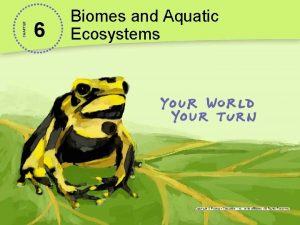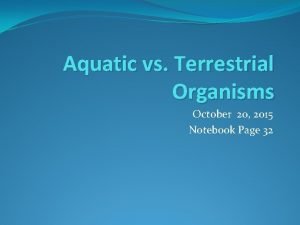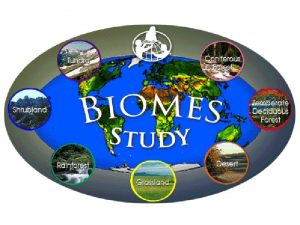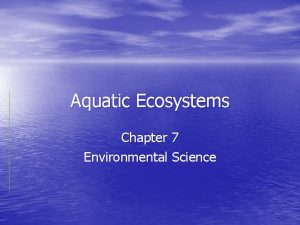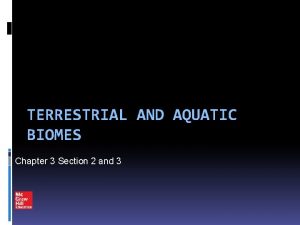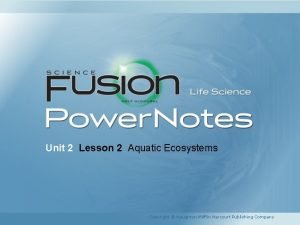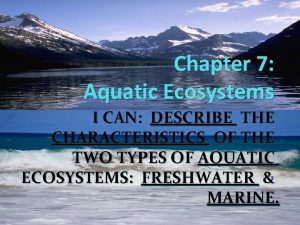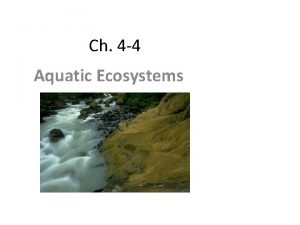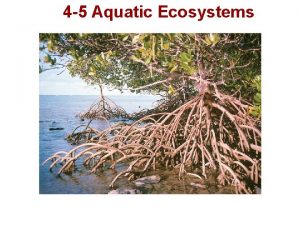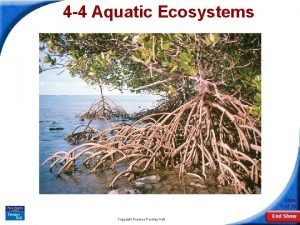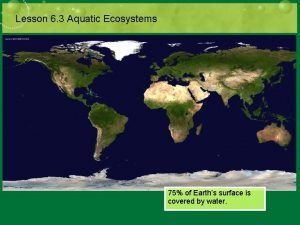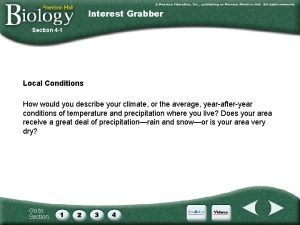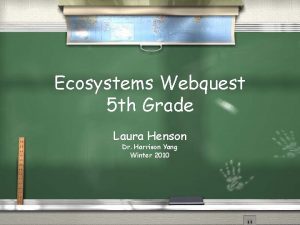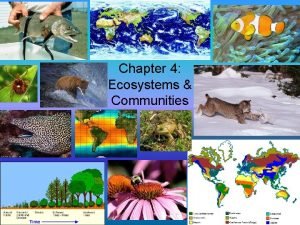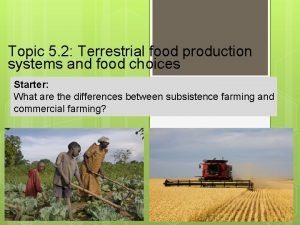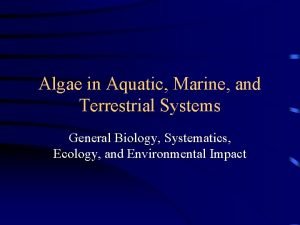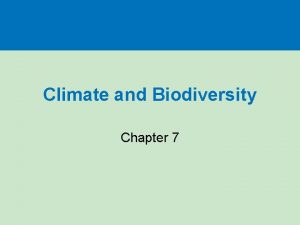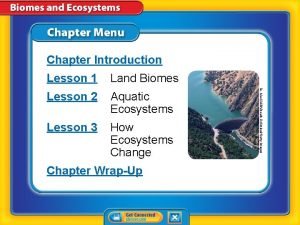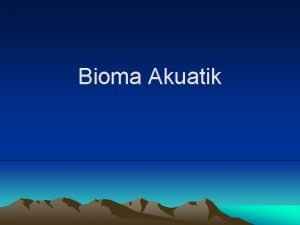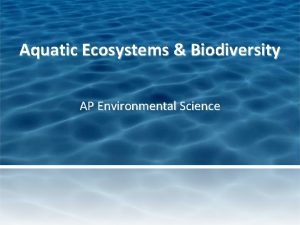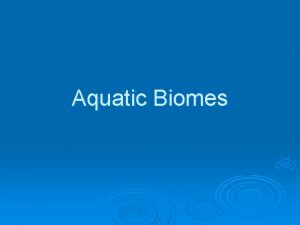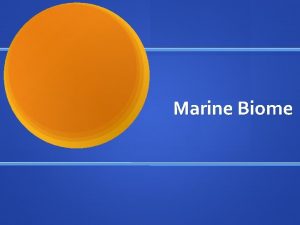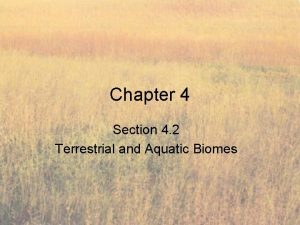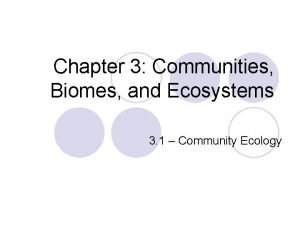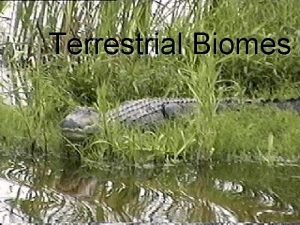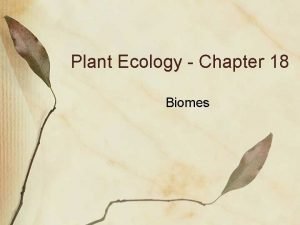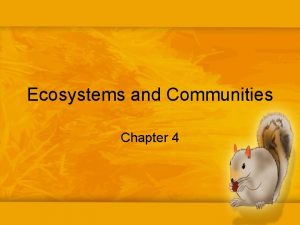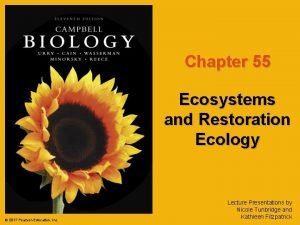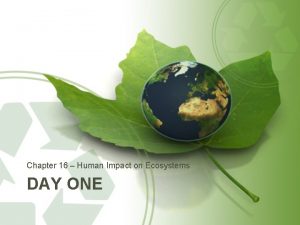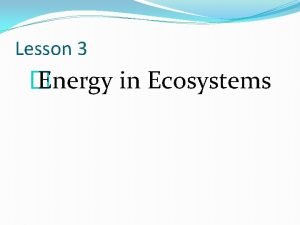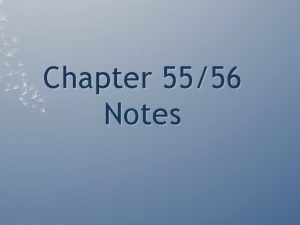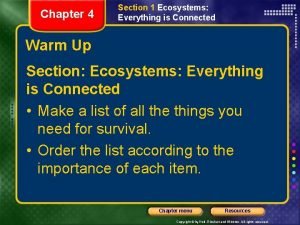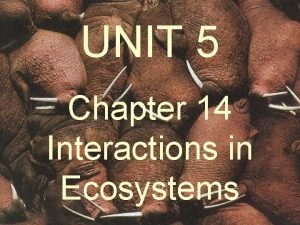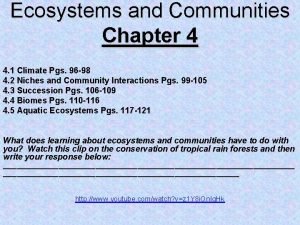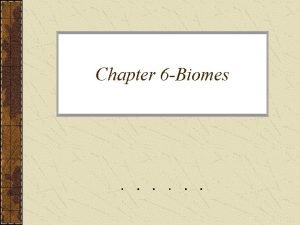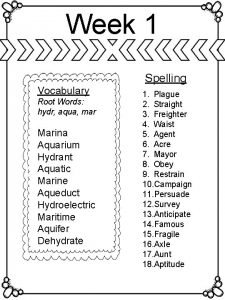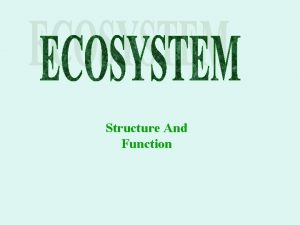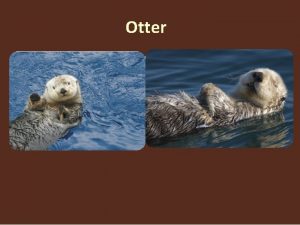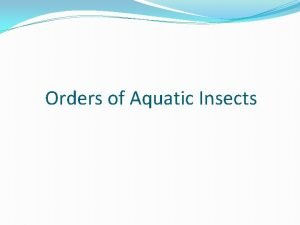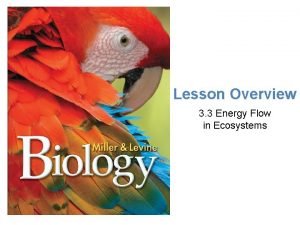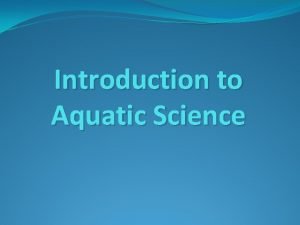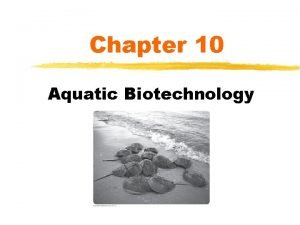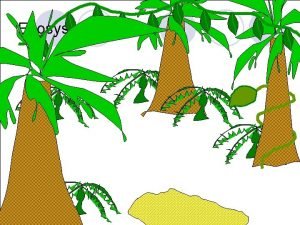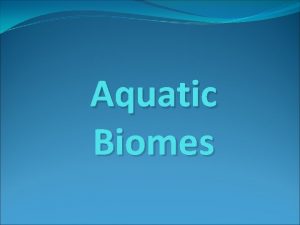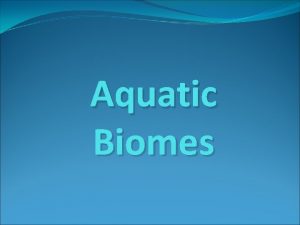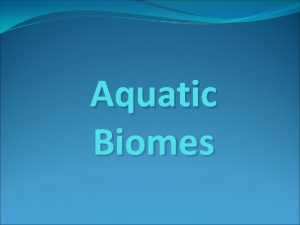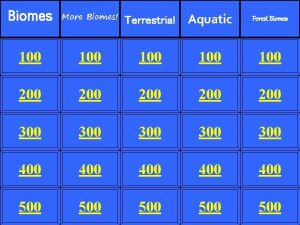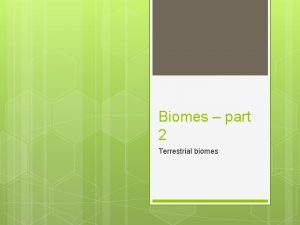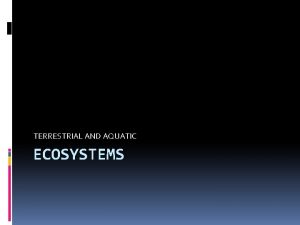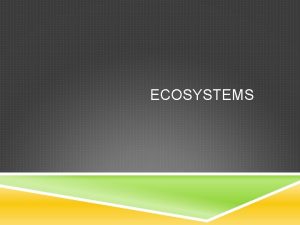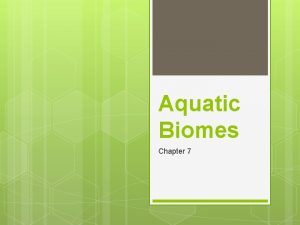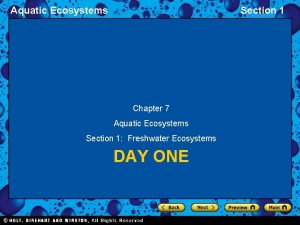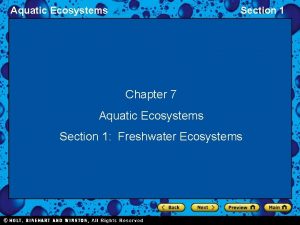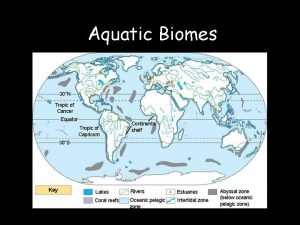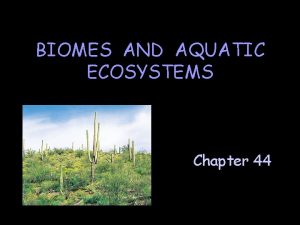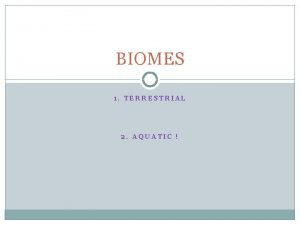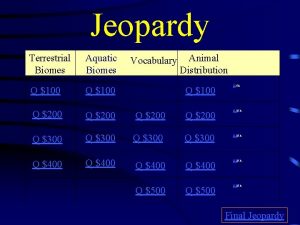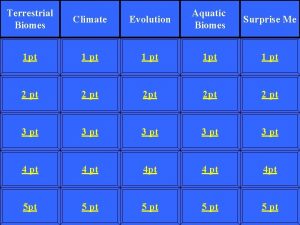Chapter 4 Terrestrial Biomes Aquatic Ecosystems Terrestrial biomes

Chapter 4 Terrestrial Biomes & Aquatic Ecosystems

Terrestrial biomes n n Named for predominant vegetation Also have characteristic animals

Boundaries? n n No sharp boundaries between biomes Intergrades

Importance of climate n Prevailing climate is most important factor in determining what kind of biome will develop n Precipitation, temperature are most important

Desert biomes n n <10 inches (<25. 4 cm) of rain per year Cool Temperate Tropical

Grassland biomes n n 10 -30 inches (25. 4 -76. 2 cm) of rain per year Tundra Temperate grassland Tropical savanna

Forest biomes n n >30 inches (>76. 2 cm) of rain per year Taiga or coniferous forest Temperature deciduous forest Tropical rain forest

Aquatic ecosystems n Initial categories based on salinity n n n Freshwater Marine Estuary

Freshwater - nonmoving n Standing waters n n n Lakes Ponds Significant stratification in community structure n n Light Temperature

Freshwater - moving n n Moving waters Rivers Streams Communities change from headwaters (source) to mouth as environment changes

Headwaters vs. mouth n Headwaters n n Cool High current velocities Few nutrients Mouth n n Warmer Slower More turbid More nutrients

Marine n Vertical and horizontal changes n n Light Temperature Nearshore Open ocean

Estuary n Freshwater rivers merge with oceans n n n Mixing zone Very high productivity Threatened by pollution

Climatograph

Climograph n n Temperature, precipitation not sole determiners Overlap among different biomes on plot suggests that other factors also are important n n n Seasonality of precipitation Temperature fluctuations around mean Soil composition (based on geology)

Deserts n n Lands where evaporation exceeds rainfall High evaporation rate n 7 -50 X precipitation

Deserts n n n Occur in 2 distinct belts between 15 -35° N & S latitude Result primarily from worldwide circulation of air masses (dry over deserts) ~25% of world’s land mass


True deserts n <10 inches of rain per year n n n Semi-deserts may have 2 -3 X that, but have high evaporation rates Low humidity results in very hot days, but cool or cold nights Life is keyed to rainfall events n Infrequent, but usually heavy when they occur

Desert life n Plants, animals are either drought evaders or drought resistors

Evaders n n Plants survive dry periods as seeds, but germinate, grow, and reproduce after rainfall Animals may hibernate (cold) or estivate (hot) n Dormancy during dry period E. g. , spadefoot toad emerges to reproduce in pools formed after rain n E. g. , birds migrate in and out n

Resistors - plants n Plants develop deep roots to become independent of rainfall events (woody shrubs) or are succulents to store water in stems (cactus)

Resistors - animals n n Behavioral adaptations Come out only at night - spiders, scorpions, rodents, predators

Resistors - animals n n Physiological adaptations No need to drink n Kangaroo rate with super kidneys gets all water from seeds

Grasslands n Tropical savannas - grasslands with scattered individuals trees n Central S. Amer. , Central & S. Africa

Savannas n n n 3 distinct seasons Cool-dry, hot-dry, warm-wet Frequent fires suppress trees, maintain grasses and forbs n n Herbaceous, low-growing annuals & perennials (dicots) Regrow from roots or seeds every year

Savannas n n Large herbivores (zebras, giraffes) and burrowing animals most common Most active during the rainy season

Temperate grasslands n Similar to tropical savanna, but occur in cooler regions n n n N. Amer. prairie (French for plains) Russian steppe Hungarian pusztas S. Amer. pampas African veldt

Temperate grasslands n n n At one time covered 42% of world land surface Much under cultivation today Excellent soils n Rich topsoil layer

Temperate grassland climate n n High rates of evaporation Periodic severe drought Rainfall ~25 -75 cm/year Too light to support forest, but too heavy to encourage desert

Temperate grassland grasses n Sod-forming n n Kentucky bluegrass Bunch grasses n Big, little bluestem

Temperate grasslands n n Most require periodic fires for maintenance, renewal, elimination of incoming/invading woody growth Animal life dominated by grazing and burrowing species

Tundra n n Northernmost limits for plant growth, and at high altitudes Plants generally low-growing n Mat or shrubby

Arctic tundra n Encircles north pole n Brief warm summers with nearly 24 hrs of sun/day Presence of permafrost Water-logged soils - low evaporation Shrubs, sedges grasses, mosses, lichens n n n

Alpine tundra n n At high elevations at all latitudes Variable daylength, many of the same restrictions, plant species

Tundra animals n Migratory, well-suited for cold climate n n Musk oxen, caribou, reindeer Lemmings, white fox, snowy owl

Tropical forests n n Equatorial, mean temp. ~25°C, 12 hrs sunlight per day Rainfall highly variable-determines type of tropical forest present

Types of tropical forests n Thorn forests - furthest from equator, prolonged dry season

Types of tropical forests n n n Tropical deciduous forest More rainfall nearer equator, distinct wet, dry seasons Lose leaves during dry seasons

Types of tropical forests n n Tropical rain forest >250 cm of rain per year Perpetual midsummer conditions Uninterrupted plant growth

Tropical rain forests n n Contain as many species of plants and animals as all other types of ecosystems combined 4 mi 2 area - 750 species of trees, 1500 species of flowering plants

Tropical rain forests n Typically stratified into 5 layers n Each layer has characteristic plants, animals May reach height of 80 m n

Tropical rain forest soil n n Very poor - little or no topsoil Easily weathered Subsoil with iron-based clay - laterite Major problems with slash-and-burn agriculture

Tropical rain forests today n Deforestation

Deforestation n n Loss of forests at present rate will mean disappearance within next 15 -25 years Major problems will result from climate change, loss of species of medicinal, economic importance

Temperate deciduous forest n n Eastern N. Amer, N. Europe and east Moderate temps. , moderate moisture levels n 5 -6 -month growing season

Temperate deciduous forest n n n Dominated by broad-leaved deciduous trees Relatively nutrient-rich soil provides for good growth Typically have 4 layers present n n Ground, shrub, sapling, canopy Rich diversity of plant, animal life

Taiga n Boreal forest, coniferous forest n Harsh winters with lots of snow

Taiga n Dominated by conifers - spruce, pine, fir, hemlock n Best suited for short growing season because they are not deciduous n n Can carry out photosynthesis whenever temps. rise above freezing Needle shape, waxy cuticle conserve moisture

Taiga soils n n Thin, acidic, develop slowly Pine needles break down slowly in cool climate

Taiga animals n n Primarily seed, insect eaters, or those that feed on plants in or near water Squirrels, birds, elk, moose, deer, beaver, porcupine, grizzlies, wolves

Standing freshwaters n Lakes and ponds

Standing freshwaters n n Significant stratification in community structure Light n Photic zone n Phytoplankton, n zooplankton Aphotic zone n Detritus, decomposers

Moving freshwaters n Longitudinal zonation in physical, chemical characteristics n Change in producers, benthic (bottom dwelling), fish assemblages

Marine n 3/4 of world’s surface, major impact on climate, wind patterns, algae supply most of world’s oxygen

Marine

Marine n n Photic, aphotic zones (vertical) Intertidal, neritic, oceanic zones (horiz. ) n n n Intertidal-wetted, dried from tides Neritic-shallow regions over continental shelves Oceanic-beyond shelves - deep zones Pelagic-open water Benthic-sea floor n Abyssal zone-deep benthic - cold, high water pressure, no light

Deep sea fishes

Estuary n Freshwater rivers merge with oceans

Estuary n n n Not very diverse - few species tolerant of salinity Very productive - oysters, crabs, fish, waterfowl Most in danger from water pollution
- Slides: 60

